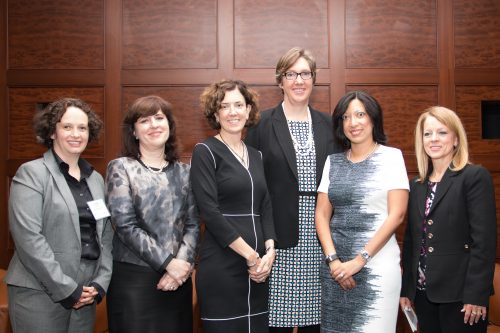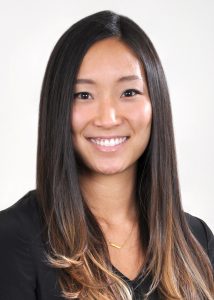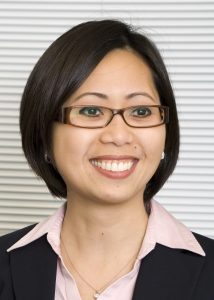 “At the start of my career, I wish I grasped how important it was to not only enjoy the work that you do but, potentially most importantly, to enjoy the people you work with,” says Accenture’s Toan Huynh. During her early days, Huynh was careful to put walls up between her work and her personal life, but now realizes that the best way to make it all work – to be successful – is to combine the two. “Throughout my career, the people that I work with have become more than colleagues. They are friends, advisors and – more than anything – have become pathways for me to gain more personal growth, more learning and to experience more adventures than I could have imagined.”
“At the start of my career, I wish I grasped how important it was to not only enjoy the work that you do but, potentially most importantly, to enjoy the people you work with,” says Accenture’s Toan Huynh. During her early days, Huynh was careful to put walls up between her work and her personal life, but now realizes that the best way to make it all work – to be successful – is to combine the two. “Throughout my career, the people that I work with have become more than colleagues. They are friends, advisors and – more than anything – have become pathways for me to gain more personal growth, more learning and to experience more adventures than I could have imagined.”
After graduating from the University of Pennsylvania with a degree in Economics and International Relations, Huynh was faced with a dilemma of sorts when she received two job offers, one in investment banking and the other in consulting. “I chose consulting because of the amazing learning opportunities I knew it would allow me, for the impact I believed I could make.” She never looked back, and since has worked across a variety of problem solving roles during her career, including being a co-founder of one of the most well respected boutique cloud services brokerage and advisory firms in the world, Cloud Sherpas, which was strategically acquired by Accenture late last year.
Accenture is a leader in helping organizations move to the cloud to take advantage of a new era of service delivery and flexibility, where applications, infrastructure and business processes are brought together and delivered As-a-Service. Accenture’s Cloud First agenda offers comprehensive, industry-focused cloud services including strategy, implementation, migration and managed services, and assets including the Accenture Cloud Platform that can drive broader transformational programs for clients. Cloud Sherpas became of an integral part of Accenture’s aptly named Cloud First Applications team, which delivers cloud services for Salesforce, Workday, ServiceNow, Google and other “pure play” cloud technologies.
“We are constantly innovating around how to be the next generation customer care solutions providers – how to stay ahead,” says Huynh, who credits much of her success and achievements to a great passion for her job and teamwork. She also is working with Accenture’s New York Metro Office to integrate the company deeper in the local NYC community, around both fintech innovation and corporate citizenship collaboration with its non-profit partners. Although Huynh has had the chance to work in most major cities around the world, “NYC continues to be a hub for all things” for her.
A Rapidly Changing World
Huynh is kept on her toes with the constantly changing environment within which she works. “Within my space, we work with forward thinking insurers and financial services firms to springboard passed the legacy system constraints and corporate culture – the old ways of customer interactions – and modernize legacy systems and processes. Customer expectations around financial services companies are changing at a rapid pace, especially as digital disruptors have changed how and where customers want to engage, across a variety of communication channels. At Accenture, our goal is to help our customers innovate using our digital and Cloud First platforms. The work has been so exciting and rewarding to see customers transform into new icons in their ecosystems.”
In Tech, More Women Leaders
Although Huynh agrees that, traditionally, the financial services and technology space has been dominated by men, she notes that, “this is changing quite drastically and with good reason.” Huynh attributes this change to more women having greater access to (and encouragement) in taking technical training, but moreover she sees the biggest area for women to succeed in this field through mentoring. “Mentorship is paramount to helping one another build networks that foster and develop women leaders in this space,” and she adds, “Accenture is a leader in this way and I am proud to do my part to mentor up-and-coming young women.”
Accenture’s commitment to women really starts at the top, with its CEO making a personal commitment to advancing gender equality, and it also set a goal to grow its’ percentage of women new hires globally to at least 40 percent by 2017. Personally, Huynh is involved with the NYC Women’s Employees Resources Group, which drives programs that support women and help them build strong networks at Accenture and in the broader community, which she finds particularly important.
“My advice for young women? Be fearless in your educational pursuits and find a great mentors early, men and women, to be your advocate and help you navigate. For my women peers? I encourage each of us to continue to use our influence and experience to help women navigate and progress in their careers, and to be a resource pool to help elevate women leaders wherever we work and volunteer.”
Life, Outside Work
As a woman tech start up founder, Huynh does her part within the tech alley and entrepreneurial community to encourage others to do what she did, by being on panels and speaking to organizations. “I want others to take a big leap of faith and dare to do something different.” She also is part of the 37 Angels – a woman only angel investing network that invests in early stage seed start-ups started by male and female founders. “Being present and being daringly ‘out there’ will hopefully help pave the way for more women leaders in the workforce.”
Huynh and her family support Opening Act, an organization which provides after school theatre programing for underprivileged kids, as a way to develop skills for life. They also support Words without Borders, which provides translations of literary works across languages to break down barriers for knowledge exchange.
She uses the skills she’s acquired throughout her career to be the best mom possible to her 21 month old daughter.









